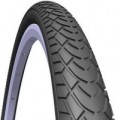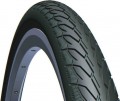Diameter
The nominal size of a tire, expressed in inches or millimeters.
When choosing according to this parameter, you need to take into account that the characteristics usually indicate not the inner, but the outer size of the tire. Thus, the overall performance properties of the product depend on the nominal size in inches, and not its compatibility with a specific rim (it is better to check compatibility according to the ERTRO standard, see below).
In general, larger wheels are good for going “far, long and at a steady speed,” while a small size provides good acceleration dynamics and is more convenient for trick riding. And in many types of bicycles there are traditional wheel sizes, optimally selected according to a number of parameters specifically for a given application. So, for
a mountain bike (MTB) you will most likely need tires with a landing
size of 26", for a road bike - 28", for a BMX -
20". However, there are exceptions, so the specific landing size must be checked before purchasing Yes, and deviations from the “native” external dimensions are quite acceptable - for example,
29" “Niner” tires usually coincide with
28-inch tires in terms of seat size.
Note that the main dimensions of a product can be indicated in different ways: two numbers (for example, 26" x 3.0"),
...three (28" x 1 1/4" x 1 3/4"), or even an alphanumeric index (700x40C). However, in any case, the first number indicates the outer size. In the last example, this size is indicated in millimeters; 700 mm in this case is equivalent to 28". If only the nominal dimensions are known for a tire and the ETRTO standard is not specified, it is best to assume that identical markings mean identical dimensions, and select a replacement model with the same numbers as the previous tires. As a last resort, if you need to select a product labeled in a different format, you can use special techniques to determine the actual dimensions; Such techniques can be found in special sources.Width
The nominal width of a tyre, in fact, is its width with a normally inflated wheel. Approximately this parameter is expressed in inches, more precisely - in millimeters. The latter option is used in bicycle tyres marked according to the “French size” (see the corresponding paragraph).
As well as the fit size (see "ETRTO Standard"), this indicator determines the compatibility of a tyre with a particular rim. However, if the size must exactly match the size of the rim, then in the case of the width, the selection rules are somewhat different. It doesn't have to exactly match the inside width of the rim - a tyre that is 1.5 to 2 times as wide is considered the best option. Up to 2.5 times is allowed, but care must be taken here: a tyre that is too wide on a narrow rim will behave worse in corners and may break off the rim. Also, excessive width impairs handling at low speed and with a pressure drop (even a small one), accelerates sidewall wear. In turn, a tyre that is too narrow is more likely to puncture and damage the rim due to abnormal loads on it.
Recall that if the marking of the tyre matches the marking of the standard tyres of the bicycle, it is guaranteed to fit it. This is true for width as well. At the same time, there are tables that allow you to determine what "non-native" tyre width is suitable for a particular rim.
ETRTO
The main dimensions of the tyre are in accordance with the ETRTO standard (the name "ISO standard" is also found). Indicated in millimetres, while the first digit corresponds to the width of the tyre, the second to the inner diameter.
The variety of markings used for bicycle tyres (including french size
650x23C,
650x25C,
650x28C,
650x35C,
650x43C,
650x48C,
650x54C,
700x20C,
700x22C,
700x23C,
700x25C,
700x26C,
700x28C,
700x30C,
700x31C,
700x32C,
700x33C,
700x34C,
700x35C,
700x38C,
700x40C,
700x42C,
700x43C,
700x45C,
700x47C,
700x50C) at one time created many problems for both users and specialists.
...Moreover, in most cases, inches were used for marking, and this is a less accurate unit of measurement than millimetres. Moreover, formally identical sizes with different designation formats often differed in fact — for example, 1.75 "and 1 3/4" inches could correspond to different actual sizes in millimetres. Also, manufacturers most often indicated in the characteristics the outer diameter of the tyre, and not the inner one, and without actual fitting it was far from always possible to choose a product to fit the rim size.
To remedy the situation, the ETRTO (ISO) standard was developed. Dimensions according to this standard are perhaps the most important parameter for selecting a bicycle tyre. First, ETRTO covers the two main characteristics that determine rim compatibility — bore diameter and width. See above for the meaning of width; and the tyre and rim must match in terms of the rim diameter — otherwise the installation will be simply impossible, no matter how perfect the other characteristics of the “rubber” may be. Secondly, ETRTO uses a designation in millimetres, which allows you to choose the tyre size with maximum accuracy.
There are tables that allow you to translate some branded "inch" markings into ETRTO values; such tables can be found in special sources. However, the need for such data rarely arises: most modern manufacturers, along with branding, also use the ETRTO standard.Load
The maximum load that the tyre can carry in normal operating condition (installed and inflated to operating pressure). Usually, this parameter is given with some margin — adjusted for the fact that during the ride there may be short-term high loads that exceed the weight on the wheel during uniform movement. So if the load on the tyre is close to the maximum indicator, but does not exceed it, you don’t have to worry about the integrity of the tyres (of course, when using them as part of the assignment). Moreover, even with a significant excess of the permissible load (by 20 – 30 kg), the product most likely will not burst immediately. However, exceeding the load definitely cannot be allowed: with an increased load, the likelihood of a tyre “explosion” increases dramatically, and it is highest at high speed, on bumps and in sharp turns — that is, in the most traumatic situations.
When determining the load on each wheel, you need to determine the total mass of the bike and the rider, and also take into account that the rear wheel accounts for about 65% of the weight, the front wheel for about 35%. To simplify the calculations, if special accuracy is not required, you can take 2/3 of the weight for the rear wheel, and 1/3 for the front wheel. For example, if a person weighs 80 kg and a bicycle weighs 10 kg, then the total weight will be 90 kg, and the front wheel will have a load of approximately 30 kg, and the rear wheel will have a load of 60 kg. However, modern “a...dult” bicycle tyres for the most part have rather high maximum load rates — often 120 kg or more. So it makes sense to look closely at this indicator mainly in specific situations: if a bike is needed for a very large and massive person, if we are talking about a children's bike (“children's” tyres can have very limited load limits), or if you plan to carry heavy cargo. If we talk about cargo, then its weight is distributed over the wheels, depending on where the luggage is located. When placed on the rear (boot or “bicycle pants”) or front wheel (city bike basket), the weight is added to the load on the corresponding wheel, and if the cyclist carries a backpack, then the weight of the combined weight of the backpack and the person is distributed according to the proportion described above.
Weight
The total weight of the tyre.
This indicator affects the overall weight of the bike, but this influence is so insignificant that in most cases it can be neglected — especially since the difference between tyres similar in size and use can be some tens of grams, or even grams. In fact, paying attention to weight makes sense mainly when used in professional racing, where the struggle sometimes goes for tenths of a second — and, accordingly, every extra gram can be decisive. If tyres are bought for simpler use — for example, amateur "rides" on roads or even cross-country — this parameter can not be given much attention.

